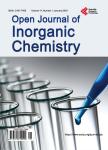Synthesis, Characterization and Biological Activities of Binuclear Metal Complexes of 2-Benzoylpyridine and Phenyl(Pyridin-2-yl) Methanediol Derived from 1-Phenyl-1-(Pyridin-2-yl)-N-(Pyrimidin-2-yl) Methanimine Dihydrate Schiff Base
Synthesis, Characterization and Biological Activities of Binuclear Metal Complexes of 2-Benzoylpyridine and Phenyl(Pyridin-2-yl) Methanediol Derived from 1-Phenyl-1-(Pyridin-2-yl)-N-(Pyrimidin-2-yl) Methanimine Dihydrate Schiff Base作者机构:Department of Inorganic Chemistry Faculty of Science University of Yaounde I Yaoundé Cameroon Department of Chemistry Faculty of Science University of Buea Buea Cameroon
出 版 物:《Open Journal of Inorganic Chemistry》 (无机化学期刊(英文))
年 卷 期:2021年第11卷第1期
页 面:20-42页
学科分类:081704[工学-应用化学] 07[理学] 08[工学] 0817[工学-化学工程与技术] 070303[理学-有机化学] 0703[理学-化学]
主 题:Binuclear Complexes Schiff Base 2-Benzoylpyridine Crystal Structure Antimicrobial Activity Antioxidant Activity
摘 要:The Schiff base, 1-phenyl-1-(pyridin-2-yl)-N-(pyrimidin-2-yl)methanimine dihydrate (L1) has been synthesized by the condensation reaction between 2-aminopyrimidine and 2-benzoylpyridine and characterized using 13C-NMR, 1H-NMR, microanalysis, FT-IR, DEPT-135, HSQC, HMBC, COZY, NOESY. The reaction of 1-phenyl-1-(pyridin-2-yl)-N-(pyrimidin-2-yl)methanimine dihydrate (L1) with salts of V(IV), Co(II) and Cu(II), however, resulted in the hydrolysis of L1 to give binuclear metal complexes of 2-benzoylpyridine (L2) and phenyl(pyridin-2-yl)methanediol (L3) which were characterized using UV-visible spectroscopy, and TGA. The single crystal x-ray structure determined for the Copper(II) complex revealed that we obtained a compound previously obtained using a different method of synthesis. The Schiff base ligand (L1) is soluble in methanol, ethanol, DMSO, acetone and DMF. Microanalysis and Spectroscopic studies indicated that binuclear metal complexes were obtained by the coordination of metal ion to 2-benzoylpyridine (L2) and phenyl(pyridin-2-yl)methanediol (L3) from the hydrolysis of L1. Spectroscopic and elemental analysis reveal the formation of square pyramidal complexes of Co(II) and Cu(II) and a square planar complex of V(IV). In vitro antibacterial and antifungal activity against three bacterial strains (Escherichia coli, Klebsiella pneumoniae and Staphylococcus aureus) and three fungal stains (Candida albicans, Candida glabrata and Candida parapsilosis) showed moderate biological activity. Antioxidant studies reveal that only the binuclear Co(II) and oxovanadium(II) complexes are potent to eliminate free radicals.



